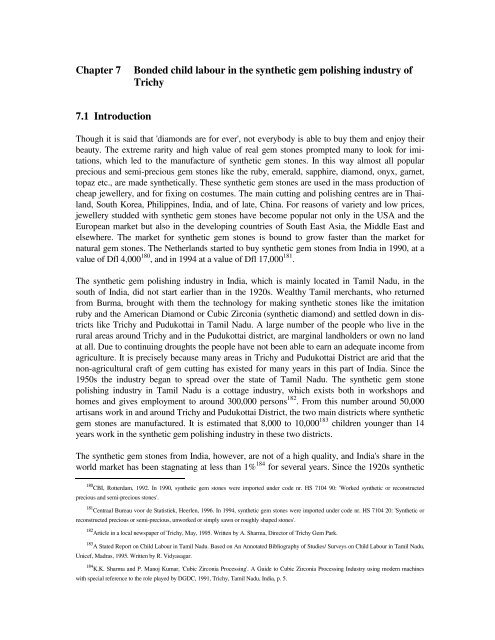You also want an ePaper? Increase the reach of your titles
YUMPU automatically turns print PDFs into web optimized ePapers that Google loves.
Chapter 7<br />
Bonded child <strong>labour</strong> <strong>in</strong> <strong>the</strong> syn<strong>the</strong>tic <strong>gem</strong> polish<strong>in</strong>g <strong>in</strong>dustry <strong>of</strong><br />
Trichy<br />
7.1 Introduction<br />
Though it is said that 'diamonds are for ever', not everybody is able to buy <strong>the</strong>m <strong>and</strong> enjoy <strong>the</strong>ir<br />
beauty. The extreme rarity <strong>and</strong> high value <strong>of</strong> real <strong>gem</strong> stones prompted many to look for imitations,<br />
which led to <strong>the</strong> manufacture <strong>of</strong> syn<strong>the</strong>tic <strong>gem</strong> stones. In this way almost all popular<br />
precious <strong>and</strong> semi-precious <strong>gem</strong> stones like <strong>the</strong> ruby, emerald, sapphire, diamond, onyx, garnet,<br />
topaz etc., are made syn<strong>the</strong>tically. These syn<strong>the</strong>tic <strong>gem</strong> stones are used <strong>in</strong> <strong>the</strong> mass production <strong>of</strong><br />
cheap jewellery, <strong>and</strong> for fix<strong>in</strong>g on costumes. The ma<strong>in</strong> cutt<strong>in</strong>g <strong>and</strong> polish<strong>in</strong>g centres are <strong>in</strong> Thail<strong>and</strong>,<br />
South Korea, Philipp<strong>in</strong>es, <strong>India</strong>, <strong>and</strong> <strong>of</strong> late, Ch<strong>in</strong>a. For reasons <strong>of</strong> variety <strong>and</strong> low prices,<br />
jewellery studded with syn<strong>the</strong>tic <strong>gem</strong> stones have become popular not only <strong>in</strong> <strong>the</strong> USA <strong>and</strong> <strong>the</strong><br />
European market but also <strong>in</strong> <strong>the</strong> develop<strong>in</strong>g countries <strong>of</strong> South East Asia, <strong>the</strong> Middle East <strong>and</strong><br />
elsewhere. The market for syn<strong>the</strong>tic <strong>gem</strong> stones is bound to grow faster than <strong>the</strong> market for<br />
natural <strong>gem</strong> stones. The Ne<strong>the</strong>rl<strong>and</strong>s started to buy syn<strong>the</strong>tic <strong>gem</strong> stones from <strong>India</strong> <strong>in</strong> 1990, at a<br />
value <strong>of</strong> Dfl 4,000 180 , <strong>and</strong> <strong>in</strong> 1994 at a value <strong>of</strong> Dfl 17,000 181 .<br />
The syn<strong>the</strong>tic <strong>gem</strong> polish<strong>in</strong>g <strong>in</strong>dustry <strong>in</strong> <strong>India</strong>, which is ma<strong>in</strong>ly located <strong>in</strong> Tamil Nadu, <strong>in</strong> <strong>the</strong><br />
south <strong>of</strong> <strong>India</strong>, did not start earlier than <strong>in</strong> <strong>the</strong> 1920s. Wealthy Tamil merchants, who returned<br />
from Burma, brought with <strong>the</strong>m <strong>the</strong> technology for mak<strong>in</strong>g syn<strong>the</strong>tic stones like <strong>the</strong> imitation<br />
ruby <strong>and</strong> <strong>the</strong> American Diamond or Cubic Zirconia (syn<strong>the</strong>tic diamond) <strong>and</strong> settled down <strong>in</strong> districts<br />
like Trichy <strong>and</strong> Pudukottai <strong>in</strong> Tamil Nadu. A large number <strong>of</strong> <strong>the</strong> people who live <strong>in</strong> <strong>the</strong><br />
rural areas around Trichy <strong>and</strong> <strong>in</strong> <strong>the</strong> Pudukottai district, are marg<strong>in</strong>al l<strong>and</strong>holders or own no l<strong>and</strong><br />
at all. Due to cont<strong>in</strong>u<strong>in</strong>g droughts <strong>the</strong> people have not been able to earn an adequate <strong>in</strong>come from<br />
agriculture. It is precisely because many areas <strong>in</strong> Trichy <strong>and</strong> Pudukottai District are arid that <strong>the</strong><br />
non-agricultural craft <strong>of</strong> <strong>gem</strong> cutt<strong>in</strong>g has existed for many years <strong>in</strong> this part <strong>of</strong> <strong>India</strong>. S<strong>in</strong>ce <strong>the</strong><br />
1950s <strong>the</strong> <strong>in</strong>dustry began to spread over <strong>the</strong> state <strong>of</strong> Tamil Nadu. The syn<strong>the</strong>tic <strong>gem</strong> stone<br />
polish<strong>in</strong>g <strong>in</strong>dustry <strong>in</strong> Tamil Nadu is a cottage <strong>in</strong>dustry, which exists both <strong>in</strong> workshops <strong>and</strong><br />
homes <strong>and</strong> gives employment to around 300,000 persons 182 . From this number around 50,000<br />
artisans work <strong>in</strong> <strong>and</strong> around Trichy <strong>and</strong> Pudukottai District, <strong>the</strong> two ma<strong>in</strong> districts where syn<strong>the</strong>tic<br />
<strong>gem</strong> stones are manufactured. It is estimated that 8,000 to 10,000 183 children younger than 14<br />
years work <strong>in</strong> <strong>the</strong> syn<strong>the</strong>tic <strong>gem</strong> polish<strong>in</strong>g <strong>in</strong>dustry <strong>in</strong> <strong>the</strong>se two districts.<br />
The syn<strong>the</strong>tic <strong>gem</strong> stones from <strong>India</strong>, however, are not <strong>of</strong> a high quality, <strong>and</strong> <strong>India</strong>'s share <strong>in</strong> <strong>the</strong><br />
world market has been stagnat<strong>in</strong>g at less than 1% 184 for several years. S<strong>in</strong>ce <strong>the</strong> 1920s syn<strong>the</strong>tic<br />
180 CBI, Rotterdam, 1992. In 1990, syn<strong>the</strong>tic <strong>gem</strong> stones were imported under code nr. HS 7104 90: 'Worked syn<strong>the</strong>tic or reconstructed<br />
precious <strong>and</strong> semi-precious stones'.<br />
181 Centraal Bureau voor de Statistiek, Heerlen, 1996. In 1994, syn<strong>the</strong>tic <strong>gem</strong> stones were imported under code nr. HS 7104 20: 'Syn<strong>the</strong>tic or<br />
reconstructed precious or semi-precious, unworked or simply sawn or roughly shaped stones'.<br />
182 Article <strong>in</strong> a local newspaper <strong>of</strong> Trichy, May, 1995. Written by A. Sharma, Director <strong>of</strong> Trichy Gem Park.<br />
183 A Stated Report on <strong>Child</strong> Labour <strong>in</strong> Tamil Nadu. Based on An Annotated Bibliography <strong>of</strong> Studies/ Surveys on <strong>Child</strong> Labour <strong>in</strong> Tamil Nadu,<br />
Unicef, Madras, 1995. Written by R. Vidyasagar.<br />
184 K.K. Sharma <strong>and</strong> P. Manoj Kumar, 'Cubic Zirconia Process<strong>in</strong>g'. A Guide to Cubic Zirconia Process<strong>in</strong>g Industry us<strong>in</strong>g modern mach<strong>in</strong>es<br />
with special reference to <strong>the</strong> role played by DGDC, 1991, Trichy, Tamil Nadu, <strong>India</strong>, p. 5.


















